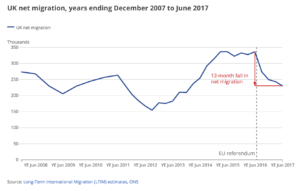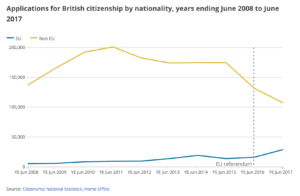- BY CJ McKinney

Six things we learned from today’s migration statistics
THANKS FOR READING
Older content is locked

A great deal of time and effort goes into producing the information on Free Movement, become a member of Free Movement to get unlimited access to all articles, and much, much more
TAKE FREE MOVEMENT FURTHER
By becoming a member of Free Movement, you not only support the hard-work that goes into maintaining the website, but get access to premium features;
- Single login for personal use
- FREE downloads of Free Movement ebooks
- Access to all Free Movement blog content
- Access to all our online training materials
- Access to our busy forums
- Downloadable CPD certificates
1. This was the biggest annual drop in net migration ever recorded
The difference between the number of people coming to live in the UK and the number leaving to live abroad was put at 336,000 in the 12 months to June 2016. Fast forward 12 months, and it’s an estimated 230,000. The Office for National Statistics confirmed to us that this fall is without precedent in its data, which goes back to 1964.

2. Immigration from the EU has fallen consistently since the referendum
Three-quarters of the change in net migration since last year is down to EU migrants. While the migration estimates are just that – estimates – there is now a clear trend: immigration from EU-27 countries has fallen since June 2016, and emigration to those countries has been rising.
The reduction in net migration was particularly from EU15 citizens (down 29,000 to +55,000) and EU8 citizens (down 34,000 to 8,000): https://t.co/38jCxLAKfQ pic.twitter.com/57dADWE7gW
— Office for National Statistics (ONS) (@ONS) November 30, 2017
3. You could blame Brexit exclusively, but not so fast
The ONS points out that “given the wider economic changes across the EU, a decrease in EU net migration might be expected”. Just as the relatively high levels of EU immigration in recent years were influenced by the UK’s robust economy compared to that of the eurozone, now the tables are turning. The falling pound may be another factor.
4. Far more EU citizens are applying for UK citizenship
This may not come to a surprise to our readers, but now there is data to back up the word on the street. “In the year to June 2017, nearly 28,500 EU nationals applied to become British citizens, up 80% compared with the previous year”, the ONS reports.
The Home Office has also issued a record number of permanent residence documents in that period: 145,000, compared to 27,000 before the referendum.
5. Asylum applications in the UK are down by a fifth
Asylum seekers make up a small proportion of the total number of immigrants to the UK. Now, Home Office data shows that “the number of asylum applications in the UK from main applicants decreased by 21% to 26,617 in the year ending September 2017”. That includes a 15% decrease in “unaccompanied asylum-seeking children”, to use the rather grotesque official parlance.
Swamped by refugees we are not.
6. Chinese and Indian citizens now make up almost half of visitors to the UK
With big increases in visit visas granted to Chinese (542,875) and Indian (427,737) nationals, those two countries now account for 47% of all visit visas granted. Good news for Harrods – as well as the wider economy.



